









|
This section provides the following transaction scenarios for the programming environments supported by Tuxedo Mainframe Adapter for SNA:
| Caution: | The scenarios in this section demonstrate how ATMI calls relate to CICS/ESA programming structures. They are not intended for use in developing application code, or for the replacement of existing application code. The use of any of these examples in actual situations may have unpredictable results. |
Each example provides a graphical illustration of the scenario followed by a description of each step of the scenario.
The examples in this section represent a few of the many programming scenarios available for using DPL and ATMI service invocations. These examples employ the most natural and efficient approaches.
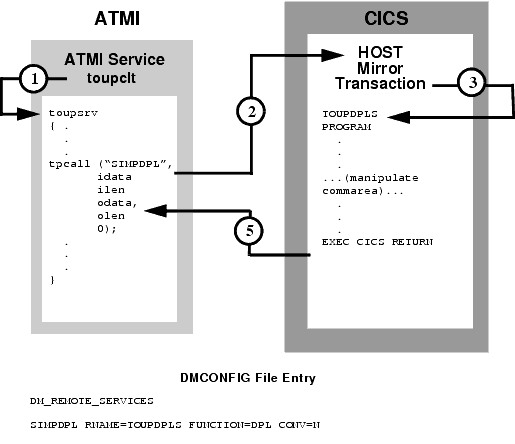
toupsrv service.toupsrv service issues tpcall for SIMPDPL, which is advertised in the DM_REMOTE_SERVICES section of the DMCONFIG file.TOUPDPLS program and passes idata buffer contents for processing.TOUPDPLS program processes data.commarea into the client’s odata buffer.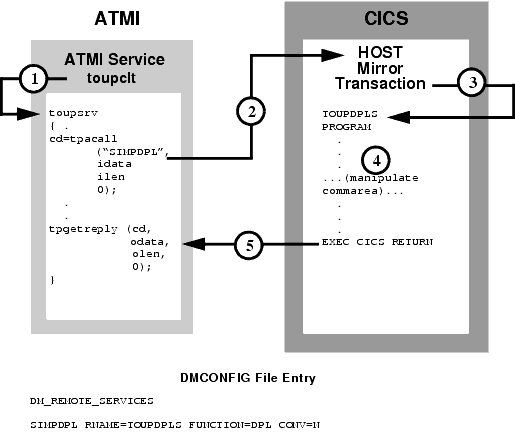
toupsrv service.toupsrv service issues tpacall for SIMPDPL, which is advertised in the DM_REMOTE_SERVICES section of DMCONFIG file.TOUPDPLS program and passes idata buffer contents for processing.TOUPDPLS program processes data.commarea into the client’s tpgetreply odata buffer.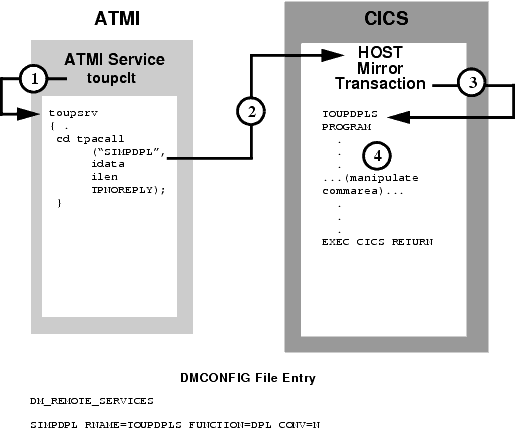
toupsrv service.toupsrv service issues tpacall for SIMPDPL, which is advertised in the DM_REMOTE_SERVICES section of DMCONFIG file. The toupsrv service uses TPNOREPLY to specify that no reply is expected.TOUPDPLS program and passes idata buffer contents for processing.TOUPDPLS program processes data.
HOPL invokes MIRRDPLC program.EXEC CICS LINK command causes the advertised service mapped to MIRRDPLS (in the DM_LOCAL_SERVICES section of the DMCONFIG file) to execute.MIRROR service processes the data received in the service TPSVCINFO data buffer from the EXEC CICS LINK.tpreturn call returns the data into the COMM-AREA buffer.
H0PL invokes MIRRDPLC program.EXEC CICS LINK command causes the advertised service mapped to MIRRDPLS (in the DM_LOCAL_SERVICES section of the DMCONFIG file) to execute. The SYNCONRETURN option indicates that the invoked service will not participate in the CICS/ESA transaction.MIRROR service request tpbegin incorporates all further operations in a transaction.MIRROR service processes the data.tpcommit indicates the end of the transaction; all updates performed within the service transaction are to be committed.tpreturn call returns the data into the commarea buffer.EXEC CICS SYNCPOINT is an explicit commit request. All updated resources in the CICS/ESA transaction are committed.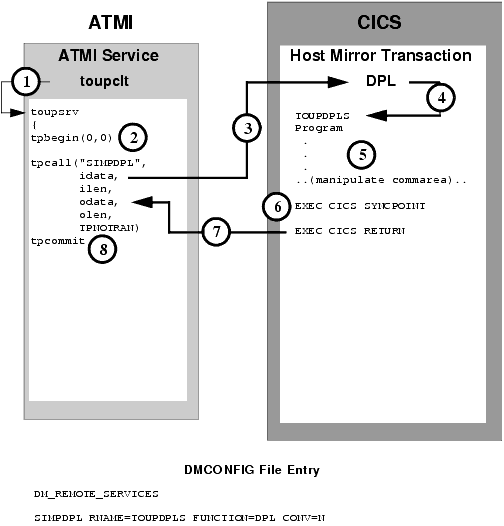
toupsrv service.toupsrv service issues tpbegin to start the transaction.toupsrv service issues tpcall for SIMPDPL, which is advertised in the DM_REMOTE_SERVICES section of the DMCONFIG file. The TPNOTRAN parameter indicates the CICS/ESA application does not participate in the service transaction.TOUPDPLS program and passes idata buffer contents for processing.TOUPDPLS program processes data.EXEC CICS SYNCPOINT is an explicit commit request. All updated resources in the CICS/ESA transaction are committed.commarea into the client’s odata buffer.toupsrv service tpcommit request signals the successful completion of the transaction, causing a commit of its own updated resources.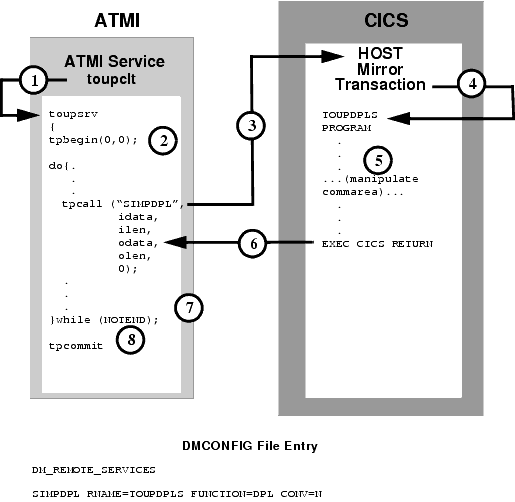
toupsrv service.toupsrv service issues tpbegin to start the transaction.toupsrv service issues tpcall for SIMPDPL, which is advertised in the DM_REMOTE_SERVICES section of the DMCONFIG file. The tpcall is requested multiple times within the same transaction.TOUPDPLS program and passes idata buffer contents for processing. The host mirror transaction remains as a long-running task to service all further requests on the transaction.TOUPDPLS program processes data.commarea into the client’s odata buffer.toupsrv service loop end conditions are met.tpcommit request indicates the successful completion of the transaction, causing a commit of its own resources and the resources held by the host mirror transaction.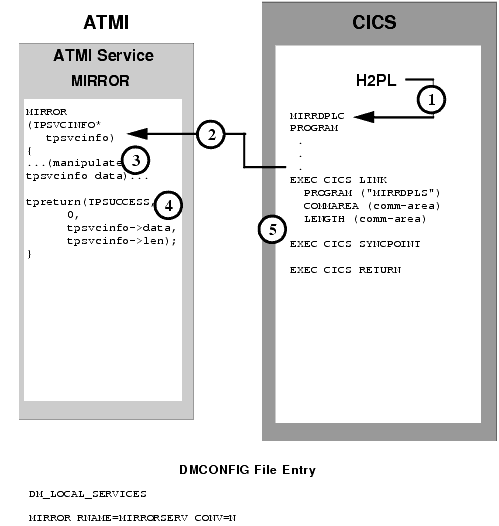
H2PL invokes MIRRDPLC program.EXEC CICS LINK command causes the advertised service mapped to MIRRDPLS (in the DM_LOCAL_SERVICES section of the DMCONFIG file) to execute. The invoked service participates in the CICS/ESA transaction.MIRROR service processes the data.tpreturn call returns the data into the commarea buffer.EXEC CICS SYNCPOINT is an explicit commit request indicating a successful end of the conversation. All updated resources in the transaction are committed.
The following examples represent programming scenarios for using DTP and ATMI service invocations.
Although it is most suited for the DPL environment, the tpcall is usually used for the DPL environment, it can also be used for a request/response to a DTP server.
The examples in this section represent some of the programming scenarios available for using DTP and ATMI service invocations. These examples employ the most natural and efficient approaches.
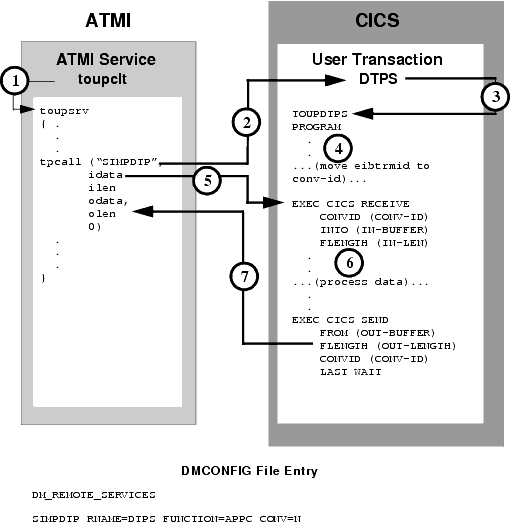
toupsrv service.toupsrv service issues tpcall for SIMPDTP, which is advertised in the DM_REMOTE_SERVICES section of DMCONFIG file.DTPS starts TOUPDTPS program.eibtrmid to a program variable. This value may be used to identify the specific conversation in your CICS/ESA APPC verbs.EXEC CICS RECEIVE command receives the idata buffer contents for processing.TOUPDTPS program processes data.EXEC CICS SEND command returns the OUT-BUFFER contents into the clients odata buffer. LAST indicates the conversation is finished. WAIT suspends processing until the data has successfully been received.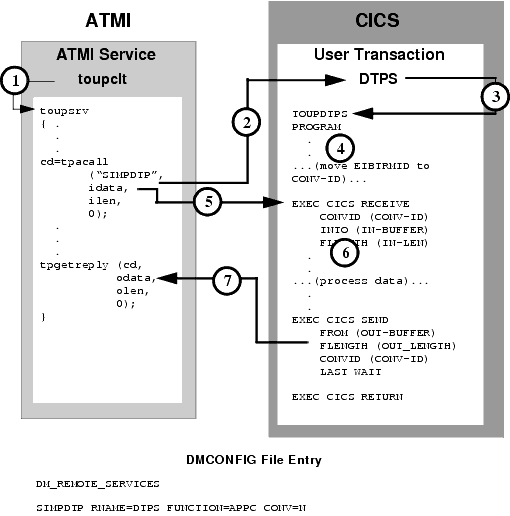
toupsrv service.toupsrv service issues tpacall for SIMPDTP, which is advertised in the DM_REMOTE_SERVICES section of the DMCONFIG file.TOUPDTPS program.EIBTRMID to a program variable. This value may be used to identify the specific conversation in your CICS/ESA APPC verbs.EXEC CICS RECEIVE command receives the idata buffer contents for processing.TOUPDTPS program processes data.EXEC CICS SEND command returns the OUT-BUFFER contents into the clients tpgetreply odata buffer. LAST indicates the conversation is finished. WAIT suspends processing until the data has successfully been received.
toupsrv service.toupsrv service issues tpacall with a TPNOREPLY request for SIMPDTP, which is advertised in the DM_REMOTE_SERVICES section of DMCONFIG file.TOUPDTPS program.EIBTRMID to a program variable. This value may be used to identify the specific conversation on your CICS/ESA APPC verbs.EXEC CICS RECEIVE command receives the idata buffer contents for processing.TOUPDTPS program processes data.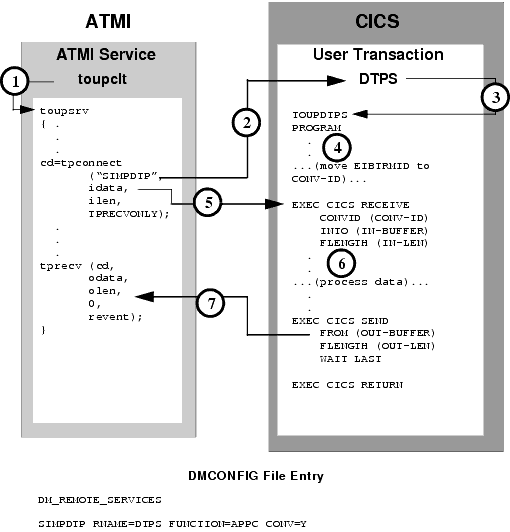
toupsrv service.toupsrv service issues tpconnect for SIMPDTP, which is advertised in the DM_REMOTE_SERVICES section of DMCONFIG file. The TPRECVONLY flag indicates the server gets control and the first conversation verb toupsrv can issue is tprecv. Data is sent on the tpconnect in the idata buffer.TOUPDTPS program.EIBTRMID to a program variable. This value may be used to identify the specific conversation on your CICS/ESA APPC verbs.EXEC CICS RECEIVE command receives the idata buffer contents for processing.TOUPDTPS program processes data.EXEC CICS SEND command returns the OUT-BUFFER contents into the clients tprecv odata buffer. WAIT suspends processing in TOUPDTPS until the data has successfully been received. LAST indicates the conversation is finished and is communicated to the tprecv as TPEV_SVCSUCC. 
toupsrv service.toupsrv service issues tpconnect for SIMPDTP, which is advertised in the DM_REMOTE_SERVICES section of DMCONFIG file. The TPSENDONLY indicates the client retains control and continues to send data. Data is sent on the tpconnect in the idata buffer.TOUPDTPS program.EIBTRMID to a program variable. This value may be used to identify the specific conversation on your CICS/ESA APPC verbs.EXEC CICS RECEIVE command receives the tpconnect idata buffer contents for processing.TOUPDTPS program processes data.EXEC CICS RECEIVE command receives the tpsend idata contents into the server’s IN-BUFFER. EXEC CICS SEND WAIT LAST returns OUT-BUFFER data in the tprecv odata buffer, along with notification that the conversation is over.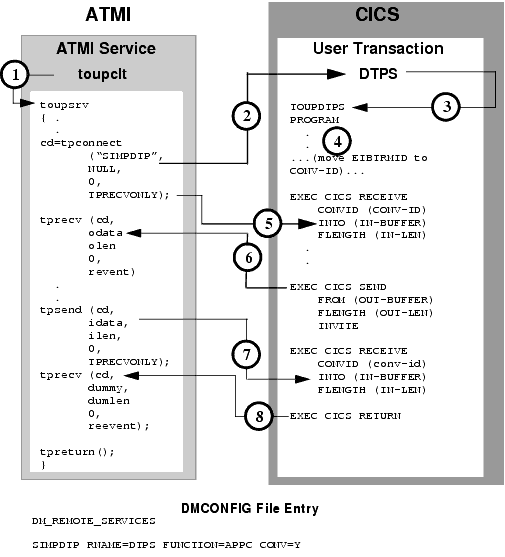
toupsrv service.toupsrv service issues tpconnect for SIMPDTP, which is advertised in the DM_REMOTE_SERVICES section of DMCONFIG file. The TPRECVONLY indicates the server gets control and the first conversation verb toupsrv can issue is tprecv.TOUPDTPS program.EIBTRMID to a program variable. This value may be used to identify the specific conversation on your CICS/ESA APPC verbs.EXEC CICS RECEIVE command receives a send state indicator from the tpconnect TPRECVONLY flag. No data is received into the INBUFFER.EXEC CICS SEND command returns the OUT-BUFFER contents into the clients tprecv odata buffer. The EXEC CICS SEND command relinquishes control to the client by using the INVITE option. This is communicated to the tprecv as TPEV_SENDONLY.EXEC CICS RECEIVE command receives the tpsend idata contents into the server’s IN-BUFFER, along with notification that the server has relinquished control.EXEC CICS RETURN ends the conversation, communicated to the tprecv as TPEV_SVCSUCC.
H0TP invokes MIRRDTPC program.EXEC CICS ALLOCATE acquires a session to the remote Tuxedo domain.EIBRSRCE to a program variable. This value is used to identify the specific conversation in your CICS/ESA APPC verbs.EXEC CICS CONNECT PROCESS command initiates the advertised service mapped to MIRROR in the DM_LOCAL_SERVICES section of the DMCONFIG file.EXEC CICS SEND command to send the contents of the OUT-BUFFER to the Tuxedo service in the tpsvcinfo->data buffer. The contents might be sent immediately.EXEC CICS SEND INVITE WAIT command sends out-buff contents into the tprecv odata buffer. The INVITE parameter relinquishes control of the conversation, seen as a TPEV_SENDONLY in the reevent parameter on the tprecv command. The data is sent immediately, along with the data from the previous SEND operation.tpreturn data returns data to the EXEC CICS RECEIVE, along with notification that the conversation completed successfully.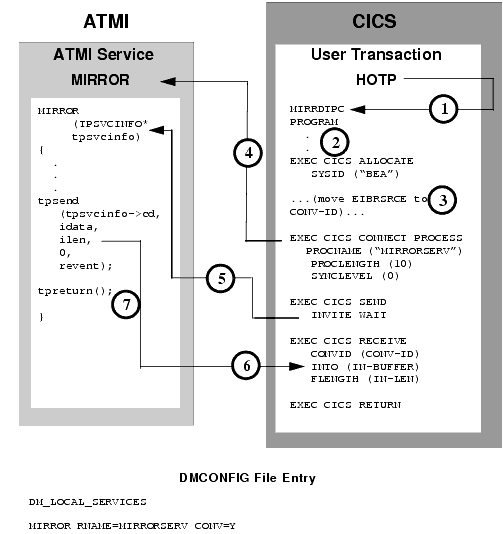
MIRRDTPC program.EXEC CICS ALLOCATE acquires a session to the remote Tuxedo domain.EIBRSRCE to a program variable. This value is used to identify the specific conversation in your CICS/ESA APPC verbs.EXEC CICS CONNECT PROCESS command initiates the advertised service mapped to MIRROR in the DM_LOCAL_SERVICES section of the DMCONFIG file.EXEC CICS SEND command relinquishes control with the INVITE WAIT option.EXEC CICS RECEIVE command receives the tpsend idata buffer contents into the IN-BUFFER.tpreturn request tears down the conversation and indicates on the EXEC CICS RECEIVE that the conversation is over.
| Note: | This is not the recommended method of performing a DTP transactional service. Please refer to the transactional DPL using request/response for the recommended method. |
toupclt invokes toupsrv service. (Note that each tpcall made in the program must be bookended with a tpbegin and a tpcommit.)tpbegin to start a transaction.toupsrv service issues tpcall for SIMPDTP, which is advertised in the DM_REMOTE_SERVICES section of the DMCONFIG file.TOUPDTPS program.EIBTRMID to a program variable. This value is used to identify the specific conversation on your CICS/ESA APPC verbs.EXEC CICS RECEIVE command receives the idata buffer contents for processing.TOUPDTPS program processes data.EXEC CICS SEND command returns the OUT-BUUFER contents into the clients odata buffer. CONFIRM indicates the conversation is finished. INVITE allows the client to respond with a COMMIT request.toupsrv service issues tpcommit to end the transaction. The COMMIT is received on the EXEC CICS RECEIVE verb and the server issues EXEC CICS RETURN to commit the resources, terminate the transaction, and free the outstanding conversation.
toupsrv service.toupsrv service issues tpbegin to start the transaction.toupsrv service issues tpconnect for SIMPDTP, which is advertised in the DM_REMOTE_SERVICES section of DMCONFIG file. The TPRECVONLY indicates the server gains control and the first conversation verb toupsrv can issue is tprecv. Data is sent on the tpconnect in the idata buffer.TOUPDTPS program.EIBTRMID to a program variable. This value may be used to identify the specific conversation on your CICS/ESA APPC verbs.EXEC CICS RECEIVE command receives the idata buffer contents for processing.TOUPDTPS program processes data.EXEC CICS SEND command returns the OUT-BUFFER contents into the clients tprecv odata buffer. CONFIRM indicates that the conversation is finished and is communicated to the tprecv as TPEV_SVCSUCC. INVITE enables the client to respond with a COMMIT request.toupsrv service issues tpcommit to end the transaction. The COMMIT is received on the EXEC CICS RECEIVE verb and the server issues EXEC CICS RETURN to commit the resources, terminate the transaction, and free the outstanding conversation.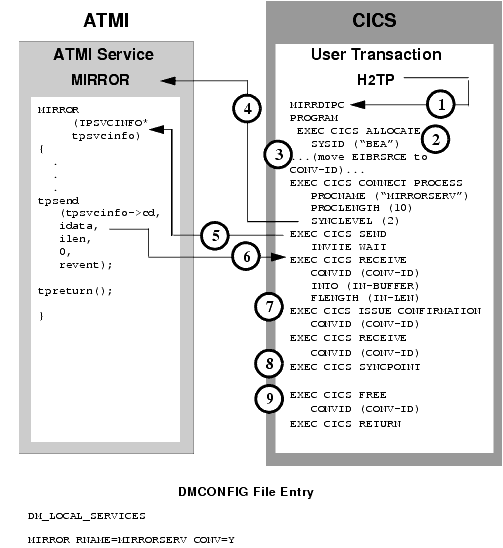
MIRRDTPC program.EXEC CICS ALLOCATE acquires a session to the remote Tuxedo domain.EIBRSRCE to a program variable. This value is used to identify the specific conversation on your CICS/ESA APPC verbs.EXEC CICS CONNECT PROCESS command initiates the advertised service mapped to MIRRDTPS. The SYNCLEVEL(2) parameter indicates the inclusion of the ATMI service in the CICS/ESA transaction.EXEC CICS SEND INVITE WAIT command causes the client to immediately relinquish control to the Tuxedo server. This is communicated to the service in TPSVCINFO as TPSENDONLY. No data is sent to the server on this request.EXEC CICS RECEIVE command receives the tpsend idata buffer contents into the IN-BUFFER. The EXEC CICS RECEIVE command receives a confirm request indicating the conversation should be terminated.EXEC CICS ISSUE CONFIRMATION verb responds positively to the confirm request.EXEC CICS SYNCPOINT is an explicit commit request to end the conversation and update all resources in the transaction. EXEC CICS FREE verb explicitly frees the outstanding conversation.
The examples in this section show the protocol exchanges between the local ATMI platform and remote host application program. The type of ATMI service request determines the nature of the client/server communication model. For requests initiated by the host application, the configuration information for the local service determines the protocol exchanges on the conversation.
Although it is most suited for the DPL environment, the tpcall is usually used in the DPL environment but can also be used for a request/response to an APPC server.
The examples in this section represent a few of the many programming scenarios available for using CPI-C and ATMI service invocations. These examples employ the most natural and efficient approaches.

toupsrv service.toupsrv service issues tpcall for SIMPCPIC, which is advertised in the DM_REMOTE_SERVICES section of the DMCONFIG file.tpname TPNCPIC invokes TOUPCPIC program. cmaccp call. The conversation id returned on the request in convid is used for all other requests on this conversation. cmrcv request receives the idata buffer contents for processingTOUPCPIC program processes data.cmsst request prepares the next send request by setting the send type to CM_SEND_AND_DEALLOCATE.cmsend request returns the obuffer contents into the client odata buffer. The buffer is flushed, and the conversation ended. 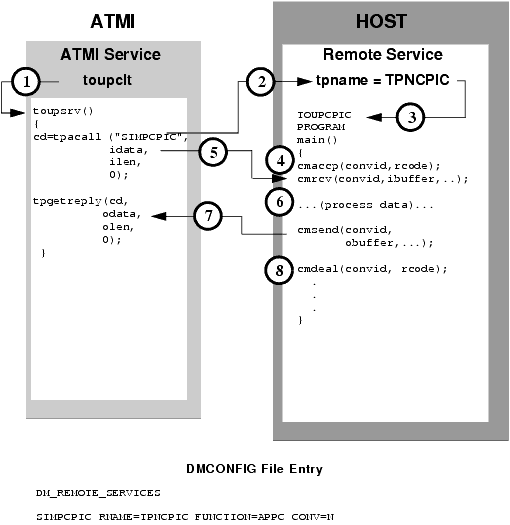
toupsrv service.toupsrv service issues tpacall for SIMPCPIC, which is advertised in the DM_REMOTE_SERVICES section of the DMCONFIG file.tpname TPNCPIC invokes TOUPCPIC program. cmaccp call. The conversation id returned on the request in convid is used for all other requests on this conversation.cmrcv request receives the idata buffer contents for processing.TOUPCPIC program processes data.cmsend command returns the obuffer contents into the client tpgetreply odata buffer. The data may not be immediately sent to the tpgetreply odata buffer on this request.cmdeal flushes the data to the client, and indicates the conversation is finished. 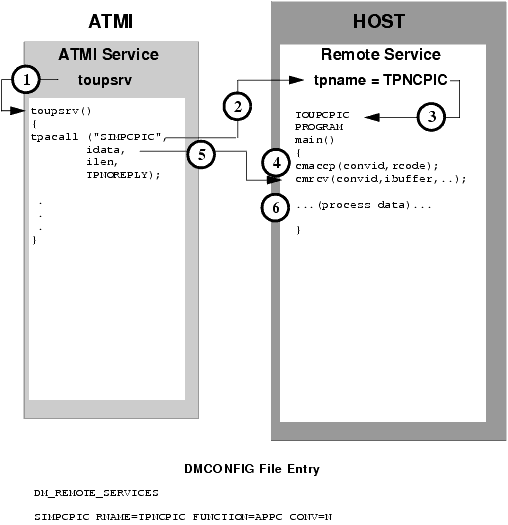
toupsrv service.toupsrv service issues tpacall with a TPNOREPLY request for SIMPCPIC, which is advertised in the DM_REMOTE_SERVICES section of the DMCONFIG file. tpname TPNCPIC invokes TOUPCPIC program.cmaccp call. The conversation id returned on the request in convid is used for all other requests on this conversation.cmrcv request receives the idata buffer contents for processing, and notification that the conversation has ended with the return code value of CM_DEALLOCATED_NORMAL.TOUPCPIC program processes data. 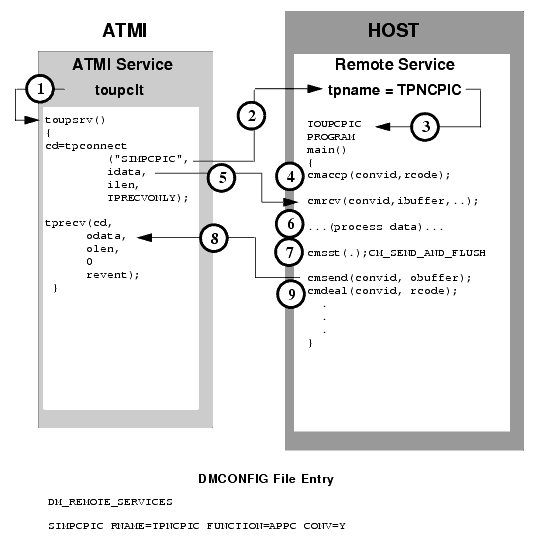
toupsrv service.toupsrv service issues tpconnect for SIMPCPIC, which is advertised in the DM_REMOTE_SERVICES section of the DMCONFIG file. The TPRECVONLY indicates the server gains control and the first conversation verb the toupsrv can issue is tprecv. Data is sent on the tpconnect in the idata buffer.tpname TPNCPIC invokes TOUPCPIC program.cmaccp call. The conversation ID returned on the request in convid is used for all other requests on this conversation.cmrcv request receives the idata buffer contents for processing.TOUPCPIC program processes data.cmsst request prepares the next send request by setting the send type to CM_SEND_AND_FLUSH.cmsend command returns the obuffer contents into the client tprecv odata buffer. The data is immediately flushed on the send request.cmdeal request ends the conversation. 
toupsrv service. toupsrv service issues tpconnect for SIMPCPIC, which is advertised in the DM_REMOTE_SERVICES section of the DMCONFIG file. The TPSENDONLY indicates the client retains control and continues to send data. No data is sent with the tpconnect.tpname TPNCPIC invokes TOUPCPIC program.cmaccp call. The conversation id returned on the request in convid is used for all other requests on this conversation.cmrcv request receives the tpsend idata buffer contents for processing. The conversation is relinquished with the TPRECVONLY flag. TOUPCPIC program processes data. cmsend returns a response in the tprecv idata buffer, along with notification from the cmdeal command that the conversation is over. The cmdeal flushes the data buffer and the tprecv reevent parameter is set to TPEV_SUCCESS. 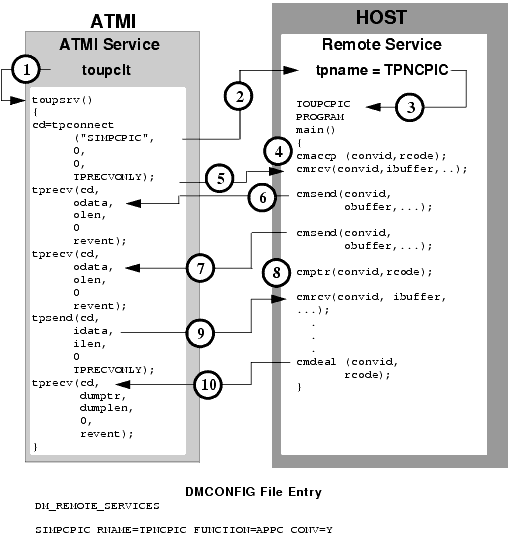
toupsrv service.toupsrv service issues tpconnect for SIMPCPIC, which is advertised in the DM_REMOTE_SERVICES section of the DMCONFIG file. The TPRECVONLY indicates the server gains control and the first conversation verb the toupsrv can issue is tprecv. tpname TPNCPIC invokes TOUPCPIC program.cmaccp request. The conversation id returned on the request in convid is used for all other requests on this conversation.cmrcv requests receives the indicator that control has been granted to the server. cmsend request returns its obuffer contents into the first client tprecv odata buffer. The data may not immediately be sent.cmsend request returns its obuffer contents into the second client tprecv odata buffer. The data may not immediately be sent.cmptr request flushes the data to the client, and grants control to the client.cmrcv request receives the tpsend idata buffer contents for processing. The TPRECVONLY is passed to the tprecv, relinquishing control of the conversation.cmdeal indicates a successful completion of the conversation to the tprecv; no data is passed.
MIRRCPIC is invoked using environment start-up specifications.MIRRCPIC client requests cminit to establish conversation attributes and receive a conversation ID that will be used on all other requests on this conversation. The remote server and service are named in the CPI-C side information entry MIRRSIDE.cmallc request initiates the advertised service mapped to MIRRORSERV in the DM_LOCAL_SERVICES section of the DMCONFIG file.cmsend request sends the contents of obuffer to the ATMI service in the tpsvcinfo->data buffer. cmdeal request flushes the data, and indicates the conversation is finished with the TPNOREPLY in the tpsvcinfo->flag field. tpreturn. 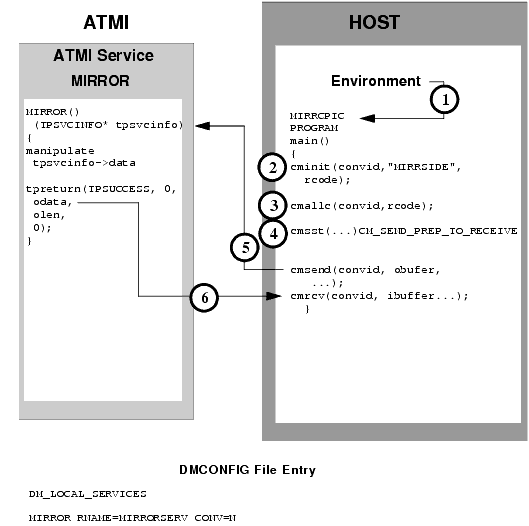
MIRRCPIC client requests cminit to establish conversation attributes and receive a conversation id that will be used on all other requests on this conversation. The remote server and service are named in the CPI-C side information entry MIRRSIDE.cmallc request initiates the advertised service mapped to MIRRORSERV in the DM_LOCAL_SERVICES section of the DMCONFIG file.cmsst request prepares the next send request by setting the send type to CM_SEND_AND_PREP_TO_RECEIVE. cmsend request immediately sends the contents of obuffer to the ATMI service in the tpsvcinfo->data buffer and relinquishes control to the mirrorserv service. cmrcv request receives the contents of the odata returned on the ATMI tpreturn service, and notification that the conversation has ended with the return code value of CM_DEALLOCATED_NORMAL. 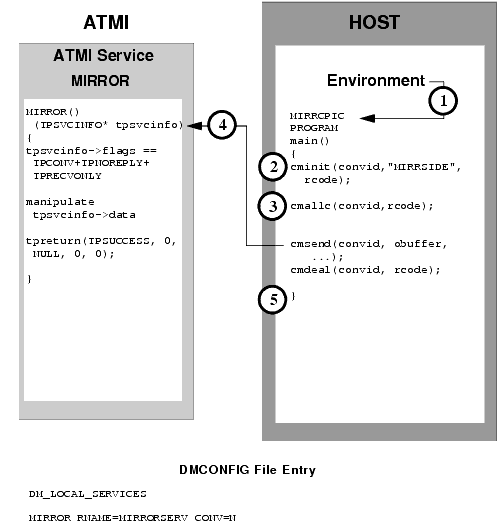
MIRRCPIC client requests cminit to establish conversation attributes and receive a conversation id that will be used on all other requests on this conversation. The remote server and service are named in the CPI-C side information entry MIRRSIDE.cmallc request initiates the advertised service mapped to MIRRORSERV in the DM_LOCAL_SERVICES section of the DMCONFIG file.cmsend request sends the contents of obuffer to the ATMI service in the tpsvcinfo->data buffer. cmdeal request flushes the data and ends the conversation, as indicated by TPNOREPLY in the tpsvcinfo->flag field. 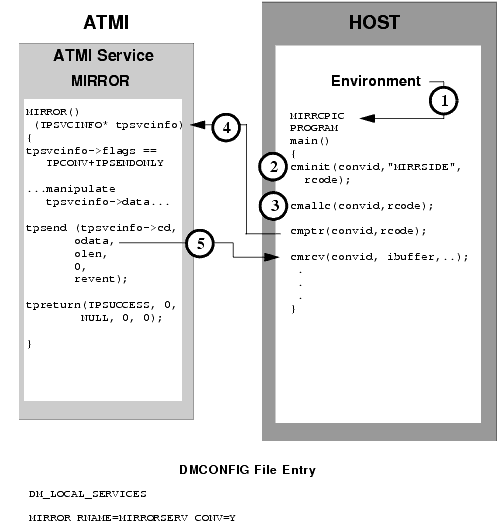
MIRRCPIC is invoked using environment start-up specifications.MIRRCPIC client requests cminit to establish conversation attributes and receive a conversation ID that will be used on all other requests on this conversation. The remote server and service are named in the CPI-C side information entry MIRRSIDE.cmallc request initiates the advertised service mapped to MIRROR in the DM_LOCAL_SERVICES section of the DMCONFIG file.cmptr relinquishes control of the conversation to the ATMI service indicated as TPSENDONLY in the tpsvcinfo->flag field. No data is passed in the tpsvcinfo->data field.cmrcv receives the contents of the tpsend odata into the ibuffer. The end of the conversation is passed from the tpreturn service as return code value CM_DEALLOCATED_NORMAL.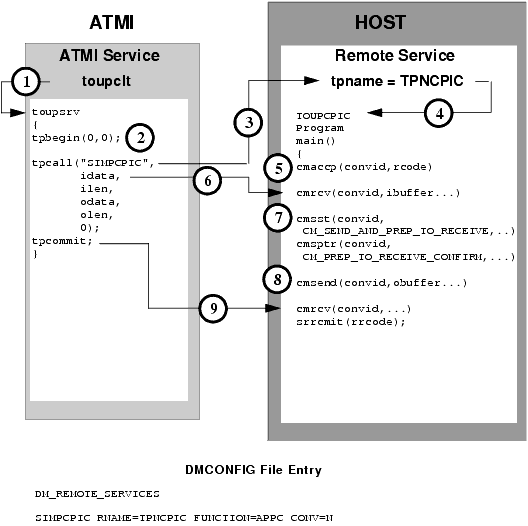
toupsrv service.toupsrv service issues tpbegin to start the transaction.toupsrv service issues tpcall for SIMPCPIC, which is advertised in the DM_REMOTE_SERVICES section of the DMCONFIG file. Data is sent from the idata buffer on the tpconnect.tpname TPNCPIC invokes TOUPCPIC program.cmaccp call. The conversation ID returned on the request in convid is used for all other requests during this conversation.cmrcv request receives the idata buffer contents for processing.cmsst and cmsptr prepare the next send request by setting the send type to CM_SEND_AND_PREP_TO_RECEIVE and by setting the prepare-to-receive type to CM_PREP_TO_RECEIVE_CONFIRM.cmsend request immediately returns the obuffer contents into the client’s odata buffer. The server relinquishes control to the server and indicates the end of the conversation with the CONFIRM request.toupsrv issues the tpcommit to successfully complete the transaction and commit all updated resources. The cmrcv request receives the commit request, and responds explicitly to the request with the SAA Resource/Recovery commit call srrcmit. The conversation is ended after the successful commit exchange.
toupsrv service.toupsrv service issues tpbegin to start the transaction.toupsrv service issues a tpconnect service request for SIMPCPIC, which is advertised in the DM_REMOTE_SERVICES section of the DMCONFIG file. Data is sent in the idata buffer on the tpconnect.tpname TPNCPIC invokes TOUPCPIC program.cmaccp call. The conversation ID returned on the request in convid is used for all other requests during this conversation.cmrcv request receives the idata buffer contents sent on the tpconnect for processing.TOUPCPIC program processes the data.cmsend returns the obuffer contents into the client’s tprecv odata buffer. The buffer contents may not be sent immediately.cmsptr prepares the prepare-to-receive request with CM_PREP_TO_RECEIVE_CONFIRM. The cmptr request with CONFIRM indicates that the conversation is finished and is communicated to the tprecv as TPEV_SVCSUCC. toupsrv issues the tpcommit to successfully complete the transaction and commit all updated resources. The cmrcv request receives the commit request and responds explicitly to the request with the SAA Resource/Recovery commit call srrcmit. The conversation is ended after the successful commit exchange.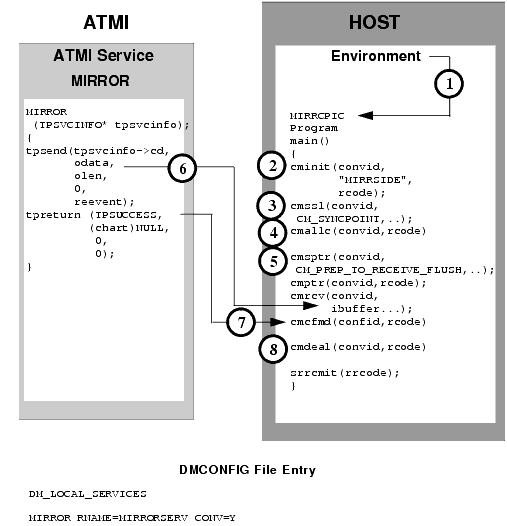
MIRRCPIC is invoked using environment start-up specifications.MIRRCPIC client requests cminit to establish conversation attributes and receive a conversation ID that will be used on all other requests on this conversation. The remote server and service are named in the CPI-C side information entry MIRRSIDE.cmssl sets the conversation attributes to sync-level 2 with CM_SYNCPOINT. This allows the ATMI service to participate in the transaction.cmallc request initiates the advertised service mapped to MIRRORSERV in the DM_LOCAL_SERVICES section of the DMCONFIG file.cmsptr sets the prepare-to-receive type to CM_RECEIVE_AND_FLUSH. The cmptr request immediately relinquishes control.MIRROR service sends the data contents of the odata buffer to the cmrcv ibuffer. The cmrcv receives a confirm request from the server indicating the conversation should be terminated. cmcfmd.MIRRCPIC client prepares to free the conversation with the cmdeal request. The conversation in CM_DEALLOCATE_SYNC_LEVEL commits all updated resources in the transaction and waits for the SAA resource recovery verb, srrcmit. After the commit sequence has completed, the conversation terminates.

The following list describes the process for implicit attachment as illustrated in Figure 2-1:
TRN1DATA, which is advertised as a remote service in the DMCONFIG file. It is a DPL request to a program named SVC1 in the CICS/ESA region.TRN1) are extracted and passed to the CICS/ESA region as the invoking TRANSID. No CICS/ESA resource definition for the TRANSID is required in the region.DFHMIRS. The program performs the DTP requests for the service.TRANSID (TRN1) and then invokes the application service program SVC1.The program can interrogate the EIBTRNID field to find this value. 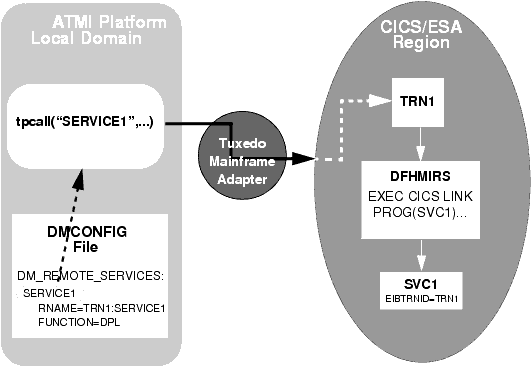
The following list describes the process for explicit attachment as illustrated in Figure 2-2:
SERVICE1, which is advertised as a remote service in the DMCONFIG file. The FUNCTION option indicates the remote service is invoked as a DPL.TRN1 as an alternate mirror transaction ID for the remote region, along with the remote program name SERVICE1.TRN1 ID is attached instead of the default mirror transaction, CSMI or CVMI. The TRN1 ID must be defined as a transaction resource in the remote region and must point to the mirror transaction program DFHMIRS.DFMMIRS calls the server application program, passing the TRN1 ID in the EIBTRNID field.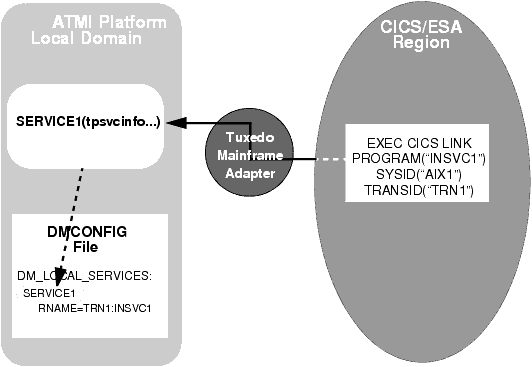
The following list describes the process for implicit attachment as illustrated in Figure 2-3:
INSVC1, which is a local ATMI service. The SYSID and PROGRAM values in the request identify the local system and the name of the local service. The TRANSID option indicates the mirror transaction to be initiated.PROGRAM and mirror TRANSID are extracted from the DPL request and are used to find an exact RNAME match in the DM_LOCAL_SERVICES section of the DMCONFIG file.SERVICE1, which is advertised locally in the ATMI platform application, is initiated.
Additional information about CICS/ESA Intersystem Communications may be found in the following IBM publications:


|